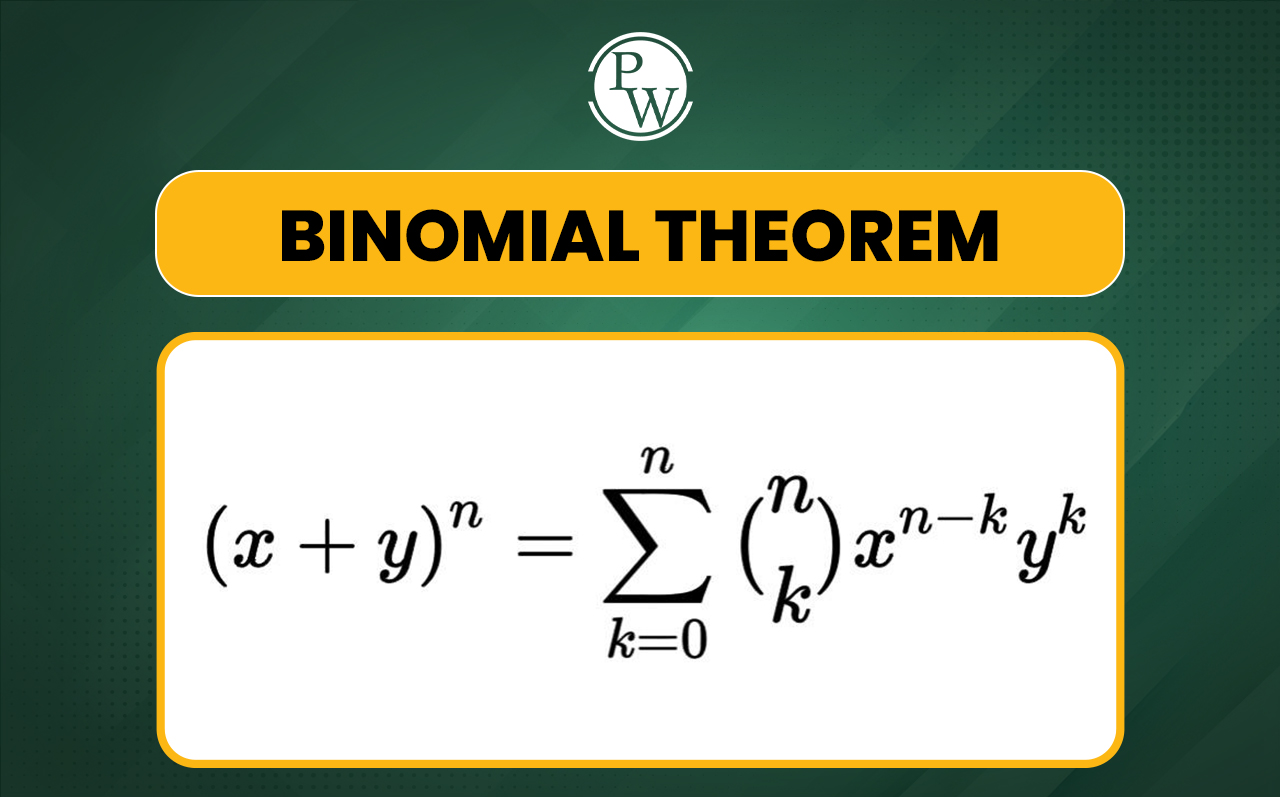Binomial Theorem Properties
The Binomial Theorem follows some key properties that make it easier to expand and analyze binomial expressions. Here’s a simple breakdown of these properties:Number of Terms: In the expansion of (x + y)ⁿ, the total number of terms is (n + 1).
Example: (x + y)³ expands to x³ + 3x²y + 3xy² + y³ (4 terms because n + 1 = 4). First and Last Terms: The first term is always xⁿ , and the last term is always yⁿ .For example:
In (x + y)⁵, the first term is x⁵, and the last term is y⁵. General Term : Any term in the expansion is found usingFor example:
In (x + y)⁴, the 3rd term (when r = 2) is:Values for Small n: When n is small, the expansions follow simple patterns:
(a+b) 0 =1 (a+b) 1 =a+b (a+b) 2 =a 2 +2ab+b 2 (a+b) 3 =a 3 +3a 2 b+3ab 2 +b 3 (a + b)Binomial Coefficients Symmetry: The coefficients are symmetrical:
Example: In (x + y)⁵ , the coefficients 1, 5, 10, 10, 5, 1 are symmetric.Middle Term(s):
If n is even , the middle term is (n /2 +1) th term. If n is odd , there are two middle terms , found at (n+1/2) th and (n+3/2) th termsExample:
If n is even , there is one middle term at position: (n/2+1) th termExample: In (x+y)4(x + y)^4 ( x + y ) 4 , the middle term is:
(4/2+1)=3rd term=6x 2 y 2If n is odd , there are two middle terms at positions:
(n+1/2) th and (n+3/2)th termsExample: In (x+y) 5 , the middle terms are:
(5+1/2)=3rd term and (5+3/2)=4th termPascal’s Triangle
Key Terms in the Binomial Theorem
The Binomial Theorem involves several important terms that help in understanding and applying its expansion. Here’s a explanation of these terms:General Terms of Expansion
The general term in a binomial expansion represents any term in the expansion and helps in writing the full expression without expanding everything manually. It is given by:2. Middle Term of Expansion
The middle term is the one that appears at the center of the expansion. The number of terms in (x + y)ⁿ is n + 1 , so the middle term depends on whether n is even or odd.- If n is even, there is one middle term at position (n/2) + 1 .
- If n is odd, there are two middle terms at positions (n+1)/2 and (n+3)/2 .
3. Finding a Specific Term in Expansion
To find a specific term, we use the general term formula and substitute the required position.Example: Find the 6th term in (3x + 4)⁸ .
Using the general formula:
Calculating,
=(56)(27x 3 )(1024)=15,93,648x 34. Term Independent of x
A term is independent of x if it does not contain x . To find it, we set the power of x to zero in the general term formula.Example: Find the term independent of x in (2x + 1)⁸ .
Using the general term formula:Numerically Largest Term in Expansion
The largest term in the binomial expansion can be found using the formula:T=(n+1)∣x∣1+∣x∣
Applications of the Binomial Theorem
The binomial theorem is useful in various mathematical calculations, especially when dealing with large numbers. Some common applications include:Finding the Remainder When Dividing Large Numbers
The binomial theorem helps determine the remainder when a large number is divided by another number. Instead of performing lengthy calculations, we rewrite the number in a convenient form and expand it using the binomial theorem.Example: Find the remainder when 297 24 is divided by 15.
Solution:
First, express 297 as a sum that includes 15: 297=15+1 Now raise it to the power of 24 : (297) 24 =(15+1) 24 Using the binomial theorem, every term in the expansion except for 1²⁴ includes 15 , which is a multiple of 15. These terms do not contribute to the remainder. The only term left is 1²⁴ = 1 . Thus, the remainder when 297²⁴ is divided by 15 is 1 .2. Finding the Last Digit of a Large Number
The last digit of a number can be determined by rewriting it in a form that makes expansion easier.Example: Find the last digit of 7 10
Solution:
We rewrite 7¹⁰ as: 7 10 =(49) 5 =(50−1) 5 Now, we expand using the binomial theorem:3. Checking Divisibility
The binomial theorem helps check whether a number is divisible by another number by expanding it into terms that reveal patterns in divisibility. T This is especially useful in modular arithmetic and number theory. For example, numbers in the form (a + b)ⁿ can be expanded, and if every term except one contains the divisor as a factor, the remainder can be easily determined.The binomial theorem makes expanding expressions simple and efficient. Instead of multiplying repeatedly, it provides a formula to find each term easily. It is widely used in algebra, probability, and real-world calculations. Understanding this theorem helps solve problems faster and makes learning algebra easier.
| Related Articles | |
| Median of Triangle | Additive Inverse |
| Hyperbola | Differentiation |
| Indian Numeral System | Surface Area of Cylinder |














